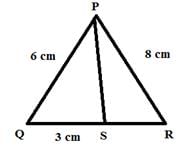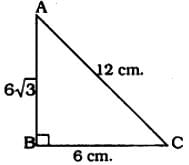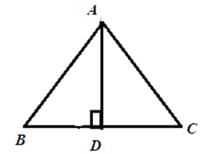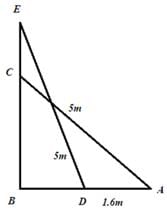All Exams >
Class 10 >
Weekly Tests for Class 10 Preparation >
All Questions
All questions of July Week 3 for Class 10 Exam
If  BC = 21 cm, then EF is equal to
BC = 21 cm, then EF is equal to- a)9 cm
- b)6 cm
- c)35 cm
- d)25 cm
Correct answer is option 'C'. Can you explain this answer?
If  BC = 21 cm, then EF is equal to
BC = 21 cm, then EF is equal to
 BC = 21 cm, then EF is equal to
BC = 21 cm, then EF is equal toa)
9 cm
b)
6 cm
c)
35 cm
d)
25 cm

|
Imk Pathshala answered |

Since, PS is the angle bisector of angle QPR
So, by angle bisector theorem,
QS/SR = PQ/PR
⇒ 3/SR = 6/8
⇒ SR = (3 X 8)/6 cm = 4 cm
It is given that ar(ΔABC) = 81 square units and ar(ΔDEF) = 64 square units. If ΔABC ~ ΔDEF, then- a)AB/DE = 81/64
- b)

- c)AB/DE = 9/8
- d)AB = 81 units, DE = 64 units
Correct answer is option 'C'. Can you explain this answer?
It is given that ar(ΔABC) = 81 square units and ar(ΔDEF) = 64 square units. If ΔABC ~ ΔDEF, then
a)
AB/DE = 81/64
b)

c)
AB/DE = 9/8
d)
AB = 81 units, DE = 64 units

|
Imk Pathshala answered |
In triangle ACB and ADC
∠A=∠A
∠ACB = ∠CDA
Therefore triangle ACB and ADC are similar,
Hence
AC/AD = AB/AC
AC2 = AD X AB
82 = 3 x AB
⇒ AB = 64/3
This implies,
BD = 64/3 – AD
⇒ BD = 55/3
∠A=∠A
∠ACB = ∠CDA
Therefore triangle ACB and ADC are similar,
Hence
AC/AD = AB/AC
AC2 = AD X AB
82 = 3 x AB
⇒ AB = 64/3
This implies,
BD = 64/3 – AD
⇒ BD = 55/3
In triangle ABC, if AB = 6√3 cm, AC = 12 cm and BC cm, then ∠B is - a)120°
- b)60°
- c)90°
- d)45°
Correct answer is option 'C'. Can you explain this answer?
In triangle ABC, if AB = 6√3 cm, AC = 12 cm and BC cm, then ∠B is
a)
120°
b)
60°
c)
90°
d)
45°
|
|
Gaurav Kumar answered |

Here largest side is 12 cm.
If the square of the hypotenuse is equal to the square of the other two sides, then it is a right-angled triangle.
If the square of the hypotenuse is equal to the square of the other two sides, then it is a right-angled triangle.
∴ c2 = a2 + b2
AC2 = AB2 + BC2
(12)2 = (63)2 + (6)2
44 = 36 × 3 + 36
144 = 108 + 36
144 = 144
∴ ∆ABC is a right angled triangle and angle opposite to hypotenuse, ∠B = 90°.
In ΔLMN and ΔPQR, ∠L = ∠P, ∠N = ∠R and MN = 2QR. Then the two triangles are- a)Congruent but not similar
- b)Similar but not congruent
- c)neither congruent nor similar
- d)Congrunt as well as similar
Correct answer is option 'B'. Can you explain this answer?
In ΔLMN and ΔPQR, ∠L = ∠P, ∠N = ∠R and MN = 2QR. Then the two triangles are
a)
Congruent but not similar
b)
Similar but not congruent
c)
neither congruent nor similar
d)
Congrunt as well as similar

|
EduRev Class 10 answered |
According to question,
ΔABC ~ ΔDEF,
AB = 4 cm, DE = 6 cm, EF = 9 cm and FD = 12 cm,
Therefore,
AB/DE = BC/EF = AC/DF
4/6 = BC/9 = AC/12
⇒ 4/6 = BC/9
⇒ BC = 6 cm
And
4/6 = AC/12
⇒ AC = 8 cm
Perimeter = AB + BC + CA
= 4 + 6 + 8
= 18 cm
ΔABC ~ ΔDEF,
AB = 4 cm, DE = 6 cm, EF = 9 cm and FD = 12 cm,
Therefore,
AB/DE = BC/EF = AC/DF
4/6 = BC/9 = AC/12
⇒ 4/6 = BC/9
⇒ BC = 6 cm
And
4/6 = AC/12
⇒ AC = 8 cm
Perimeter = AB + BC + CA
= 4 + 6 + 8
= 18 cm
If in triangles ABC and DEF, AB/EF = AC/DE, then they will be similar when- a)∠A = ∠D
- b)∠A = ∠E
- c)∠B = ∠E
- d)∠C = ∠F
Correct answer is option 'B'. Can you explain this answer?
If in triangles ABC and DEF, AB/EF = AC/DE, then they will be similar when
a)
∠A = ∠D
b)
∠A = ∠E
c)
∠B = ∠E
d)
∠C = ∠F

|
Crafty Classes answered |
The altitude divides the opposite side into two equal parts,
Therefore, BD = DC = 4 cm

In triangle ABD
AB2 = AD2 + BD2
82 = AD2 + 42
AD2 = 64 – 16
AD2 = 48
AD = 4√3 cm
Therefore, BD = DC = 4 cm

In triangle ABD
AB2 = AD2 + BD2
82 = AD2 + 42
AD2 = 64 – 16
AD2 = 48
AD = 4√3 cm
A square and a rhombus are always - a)similar
- b)congruent
- c)similar but not congruent
- d)neither similar nor congruent
Correct answer is option 'D'. Can you explain this answer?
A square and a rhombus are always
a)
similar
b)
congruent
c)
similar but not congruent
d)
neither similar nor congruent

|
Kamna Science Academy answered |
Let AC be the ladder of length 5m and BC = 4m be the height of the wall where ladder is placed. If the foot of the ladder is moved 1.6m towards the wall i.e. AD = 1.6 m, then the ladder is slided upward to position E i.e. CE = x m.

In right triangle ABC
AC2 = AB2 + BC2
⇒52 = AB2 + 42
⇒ AB = 3m
⇒ DB = AB – AD = 3 – 1.6 = 1.4m
In right angled ΔEBD
ED2 = EB2 + BD2
⇒ 52 = EB2 + (1.4)2
⇒ EB = 4.8m
EC = EB – BC = 4.8 – 4 = 0.8m

In right triangle ABC
AC2 = AB2 + BC2
⇒52 = AB2 + 42
⇒ AB = 3m
⇒ DB = AB – AD = 3 – 1.6 = 1.4m
In right angled ΔEBD
ED2 = EB2 + BD2
⇒ 52 = EB2 + (1.4)2
⇒ EB = 4.8m
EC = EB – BC = 4.8 – 4 = 0.8m
Sides of triangles are (i) 3 cm, 4 cm, 6 cm. (ii) 4 cm, 5 cm, 6 cm. (iii) 7 cm, 24 cm, 25 cm (iv) 5 cm, 10 cm, 14 cm. Which of these is right triangle?
- a)(i)
- b)(ii)
- c)(iii)
- d)(iv)
Correct answer is option 'C'. Can you explain this answer?
Sides of triangles are (i) 3 cm, 4 cm, 6 cm. (ii) 4 cm, 5 cm, 6 cm. (iii) 7 cm, 24 cm, 25 cm (iv) 5 cm, 10 cm, 14 cm. Which of these is right triangle?
a)
(i)
b)
(ii)
c)
(iii)
d)
(iv)
|
|
Radha Iyer answered |
On verification, triangle with sides 7 cm, 24 cm and 25 cm is a right triangle
∵ (25)2 = (7)2 + (24)2.
∵ (25)2 = (7)2 + (24)2.
The length of each side of a rhombus whose diagonals are of lengths 10 cm and 24 cm is- a)25 cm
- b)13 cm
- c)26 cm
- d)34 cm
Correct answer is option 'B'. Can you explain this answer?
The length of each side of a rhombus whose diagonals are of lengths 10 cm and 24 cm is
a)
25 cm
b)
13 cm
c)
26 cm
d)
34 cm

|
Crafty Classes answered |
Since O is the point of intersection of two equal chords AB and CD such that OB = OD,
As chords are equal and OB = OD, so AO will also be equal to OC
Also ∠AOC = ∠DOB = 450
Now in triangles OAC and ODB
AO/OB = CO/OD
And ∠AOC = ∠DOB = 450
So triangles are isosceles and similar.
As chords are equal and OB = OD, so AO will also be equal to OC
Also ∠AOC = ∠DOB = 450
Now in triangles OAC and ODB
AO/OB = CO/OD
And ∠AOC = ∠DOB = 450
So triangles are isosceles and similar.
What does the milky appearance of lime water in the fermentation experiment indicate?
- a)Presence of oxygen in the solution
- b)Formation of a new chemical compound
- c)Release of carbon dioxide
- d)Increase in temperature of the solution
Correct answer is option 'C'. Can you explain this answer??
What does the milky appearance of lime water in the fermentation experiment indicate?
a)
Presence of oxygen in the solution
b)
Formation of a new chemical compound
c)
Release of carbon dioxide
d)
Increase in temperature of the solution
|
|
Shantala nair answered |
Understanding Lime Water in Fermentation
In the fermentation experiment, the milky appearance of lime water is a significant observation. This phenomenon is primarily due to the release of carbon dioxide during the fermentation process. Here’s a detailed explanation:
What is Lime Water?
- Lime water is a dilute solution of calcium hydroxide (Ca(OH)2).
- It is clear and colorless when undisturbed.
What Happens During Fermentation?
- Fermentation is a metabolic process where sugars are converted into alcohol or acids by microorganisms like yeast.
- During this process, carbon dioxide (CO2) is produced as a byproduct.
Formation of Calcium Carbonate
- When carbon dioxide is bubbled through lime water, it reacts with calcium hydroxide, forming calcium carbonate (CaCO3).
- The chemical reaction can be summarized as follows:
- Ca(OH)2 + CO2 → CaCO3 (precipitate) + H2O
Indication of Carbon Dioxide Release
- The formation of calcium carbonate is what causes the milky appearance of the lime water.
- The precipitate makes the solution appear cloudy or milky, indicating that carbon dioxide is present in the solution.
Conclusion: Why Option 'C' is Correct
- The milky appearance signifies the release of carbon dioxide during fermentation, confirming option 'C' as the correct answer.
- Thus, the observation serves as a practical indicator of the fermentation process occurring, validating the metabolic activity of the microorganisms involved.
In the fermentation experiment, the milky appearance of lime water is a significant observation. This phenomenon is primarily due to the release of carbon dioxide during the fermentation process. Here’s a detailed explanation:
What is Lime Water?
- Lime water is a dilute solution of calcium hydroxide (Ca(OH)2).
- It is clear and colorless when undisturbed.
What Happens During Fermentation?
- Fermentation is a metabolic process where sugars are converted into alcohol or acids by microorganisms like yeast.
- During this process, carbon dioxide (CO2) is produced as a byproduct.
Formation of Calcium Carbonate
- When carbon dioxide is bubbled through lime water, it reacts with calcium hydroxide, forming calcium carbonate (CaCO3).
- The chemical reaction can be summarized as follows:
- Ca(OH)2 + CO2 → CaCO3 (precipitate) + H2O
Indication of Carbon Dioxide Release
- The formation of calcium carbonate is what causes the milky appearance of the lime water.
- The precipitate makes the solution appear cloudy or milky, indicating that carbon dioxide is present in the solution.
Conclusion: Why Option 'C' is Correct
- The milky appearance signifies the release of carbon dioxide during fermentation, confirming option 'C' as the correct answer.
- Thus, the observation serves as a practical indicator of the fermentation process occurring, validating the metabolic activity of the microorganisms involved.
Why is rainwater considered the purest form of natural water in certain regions?- a)It undergoes extensive purification processes
- b)It is naturally free of any contaminants
- c)It is collected directly from rivers and lakes
- d)It is untouched by human pollution
Correct answer is option 'D'. Can you explain this answer??
a)
It undergoes extensive purification processes
b)
It is naturally free of any contaminants
c)
It is collected directly from rivers and lakes
d)
It is untouched by human pollution

|
Akshay Nair answered |
Understanding Rainwater Purity
Rainwater is often considered one of the purest forms of natural water in certain regions due to several factors related to its formation and collection process.
Natural Purification Process
- Rainwater originates from the evaporation of water from the Earth's surface.
- As water vapor rises, it cools and condenses into droplets, forming clouds.
- During this process, most impurities and contaminants such as minerals, bacteria, and pollutants are left behind.
Minimal Human Interaction
- Rainwater falls directly from the atmosphere, meaning it is generally untouched by human activities.
- In remote or less industrialized areas, rainwater is less likely to come into contact with pollutants from urban runoff, industrial waste, or agricultural chemicals.
Collection Environment
- In regions with minimal air pollution, rainwater can be collected without significant contamination.
- The collection systems, often designed to capture rain directly from roofs or open surfaces, can be kept clean, maintaining the water’s purity.
Freshness and Nutrient Content
- Fresh rainwater can also contain beneficial nutrients like nitrogen, which can be advantageous for plants.
- It provides a natural resource that is often softer and more palatable compared to groundwater, which may have higher mineral content.
In summary, rainwater is considered among the purest forms of natural water because it is largely free from human-induced pollutants and contaminants, especially in regions where environmental conditions are favorable.
Rainwater is often considered one of the purest forms of natural water in certain regions due to several factors related to its formation and collection process.
Natural Purification Process
- Rainwater originates from the evaporation of water from the Earth's surface.
- As water vapor rises, it cools and condenses into droplets, forming clouds.
- During this process, most impurities and contaminants such as minerals, bacteria, and pollutants are left behind.
Minimal Human Interaction
- Rainwater falls directly from the atmosphere, meaning it is generally untouched by human activities.
- In remote or less industrialized areas, rainwater is less likely to come into contact with pollutants from urban runoff, industrial waste, or agricultural chemicals.
Collection Environment
- In regions with minimal air pollution, rainwater can be collected without significant contamination.
- The collection systems, often designed to capture rain directly from roofs or open surfaces, can be kept clean, maintaining the water’s purity.
Freshness and Nutrient Content
- Fresh rainwater can also contain beneficial nutrients like nitrogen, which can be advantageous for plants.
- It provides a natural resource that is often softer and more palatable compared to groundwater, which may have higher mineral content.
In summary, rainwater is considered among the purest forms of natural water because it is largely free from human-induced pollutants and contaminants, especially in regions where environmental conditions are favorable.
What is the purpose of adding yeast to the fruit juice or sugar solution in the fermentation process?
- a)To introduce a sweet flavor
- b)To speed up the reaction
- c)To release carbon dioxide
- d)To change the color of the solution
Correct answer is option 'C'. Can you explain this answer??
What is the purpose of adding yeast to the fruit juice or sugar solution in the fermentation process?
a)
To introduce a sweet flavor
b)
To speed up the reaction
c)
To release carbon dioxide
d)
To change the color of the solution
|
|
Pooja bhatia answered |
Understanding the Role of Yeast in Fermentation
Fermentation is a crucial biochemical process in which yeast converts sugars into alcohol and carbon dioxide. When yeast is added to fruit juice or a sugar solution, it plays several important roles.
Carbon Dioxide Production
- The primary reason for adding yeast is to facilitate the production of carbon dioxide (CO2).
- During fermentation, yeast consumes sugars, resulting in the byproduct of CO2, which creates bubbles and a fizzy texture in beverages like sparkling wine or beer.
Alcohol Formation
- Alongside CO2, yeast also produces alcohol (ethanol) as a byproduct.
- This transformation is fundamental in producing alcoholic beverages, where the desired effect is the creation of alcohol for consumption.
Flavor Development
- The fermentation process contributes to the development of unique flavors in the final product.
- Yeast can create a variety of compounds that enhance the taste profile of the beverage, but this is secondary to CO2 production.
Why Not the Other Options?
- a) Introducing a sweet flavor is incorrect because yeast converts sugars into alcohol, which generally reduces sweetness.
- b) While yeast does speed up the fermentation process, its primary role is to facilitate carbon dioxide and alcohol production.
- d) Yeast does not change the color of the solution; that is usually determined by the fruit juice or sugar used.
In summary, adding yeast to fruit juice or sugar solutions primarily serves to produce carbon dioxide, which is essential for creating the desired characteristics in fermented beverages.
Fermentation is a crucial biochemical process in which yeast converts sugars into alcohol and carbon dioxide. When yeast is added to fruit juice or a sugar solution, it plays several important roles.
Carbon Dioxide Production
- The primary reason for adding yeast is to facilitate the production of carbon dioxide (CO2).
- During fermentation, yeast consumes sugars, resulting in the byproduct of CO2, which creates bubbles and a fizzy texture in beverages like sparkling wine or beer.
Alcohol Formation
- Alongside CO2, yeast also produces alcohol (ethanol) as a byproduct.
- This transformation is fundamental in producing alcoholic beverages, where the desired effect is the creation of alcohol for consumption.
Flavor Development
- The fermentation process contributes to the development of unique flavors in the final product.
- Yeast can create a variety of compounds that enhance the taste profile of the beverage, but this is secondary to CO2 production.
Why Not the Other Options?
- a) Introducing a sweet flavor is incorrect because yeast converts sugars into alcohol, which generally reduces sweetness.
- b) While yeast does speed up the fermentation process, its primary role is to facilitate carbon dioxide and alcohol production.
- d) Yeast does not change the color of the solution; that is usually determined by the fruit juice or sugar used.
In summary, adding yeast to fruit juice or sugar solutions primarily serves to produce carbon dioxide, which is essential for creating the desired characteristics in fermented beverages.
Chapter doubts & questions for July Week 3 - Weekly Tests for Class 10 Preparation 2025 is part of Class 10 exam preparation. The chapters have been prepared according to the Class 10 exam syllabus. The Chapter doubts & questions, notes, tests & MCQs are made for Class 10 2025 Exam. Find important definitions, questions, notes, meanings, examples, exercises, MCQs and online tests here.
Chapter doubts & questions of July Week 3 - Weekly Tests for Class 10 Preparation in English & Hindi are available as part of Class 10 exam.
Download more important topics, notes, lectures and mock test series for Class 10 Exam by signing up for free.

Contact Support
Our team is online on weekdays between 10 AM - 7 PM
Typical reply within 3 hours
|
Free Exam Preparation
at your Fingertips!
Access Free Study Material - Test Series, Structured Courses, Free Videos & Study Notes and Prepare for Your Exam With Ease

 Join the 10M+ students on EduRev
Join the 10M+ students on EduRev
|

|
Create your account for free
OR
Forgot Password
OR
Signup to see your scores
go up
within 7 days!
within 7 days!
Takes less than 10 seconds to signup









